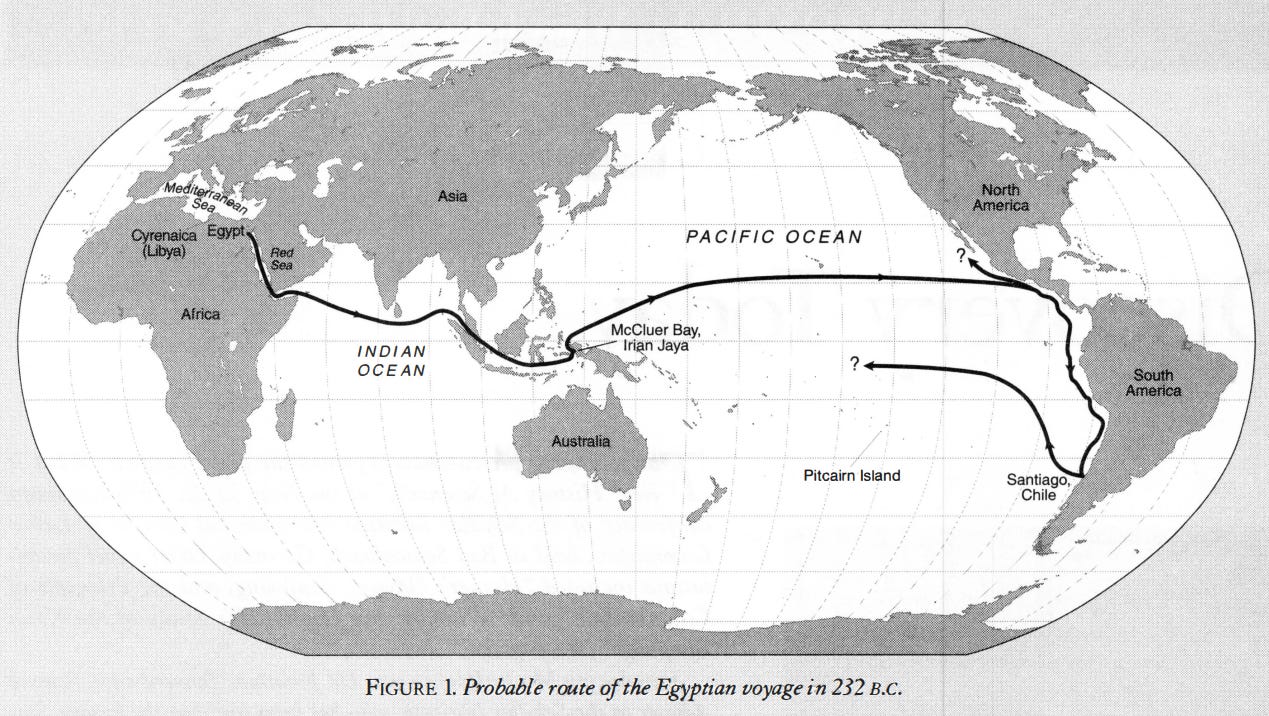A Voyage Around the World in the Third Century B. C
A native of New Zealand, (Barry) Fell was an exceptional linguist...

A flotilla of ships set sail from Egypt around 232 B.C., during the reign of Ptolemy III, on a mission to circumnavigate the globe. The six ships sailed under the direction of Captain Rata and Navigator Maui, a friend of the astronomer Eratosthenes, who was head of the Alexandria library. The commander and navigator knew from Eratosthenes that the circumference of the Earth was 250,000 stades (approximately 28,000 miles), and they had state-of-the-art astronomical and navigational equipment.
Although there is no record that the flotilla returned to Egypt, Maui and others left records of their voyage along the way. The details of the expedition are known to us through written inscriptions and drawings left in caves, primarily in what are now called the "Caves of the Navigators" in northwest New Guinea (now Irian Jaya), near McCluer Bay; a cave near Santiago, Chile; and others from Pitcairn Island and Fiji.
The New Guinea inscriptions and drawings were discovered by a German exploratory expedition in 1937, led by Josef Roder of the Frobenius Institute of Goethe University in Frankfurt, and the Chilean inscription was found in 1 885, by the Chilean-German engineer Karl Stolp, but they were not deciphered until the 1970's, when marine biologist and linguist Barry Fell figured out the connection between the Maori (Polynesian) language and a dialect of ancient Egyptian-Libyan. Hundreds more ancient Maori inscriptions exist in the Polynesian islands, and, as Fell notes, there are also inscriptions in the ancient Egyptian-Libyan in North America.
Barry Fell's Hypothesis
In the early 1970's, Fell was teaching marine biology at Harvard University. A native of New Zealand, Fell was an exceptional linguist, with a working knowledge of scores of languages, modern and ancient, including Maori. His passion for translating ancient inscriptions and his ideas about pre-Columbian settlements in America made him a controversial figure in archeology, and led him to write three books on the subject, the best known of which is America B.C. (New York: Simon & Schuster, 1976).
The specific cave transcriptions discussed here appear only in the "Occasional Papers" of the Epigraphic Society, which Fell founded in 1974; they were not generally publicized. Fell's supposition is that the expedition was sent out by Ptolemy III both to find new sources of gold for coins and to demonstrate Eratosthenes' "newly propounded doctrine." The flotilla of ships did reach South America, but never returned to Egypt. When the Egyptians did not find a navigable passageway through America, the supposition is that they turned back to return the way they had come, across the Pacific. One ship was apparently wrecked on Pitcairn Island.
Fell proposes that Rata, Maui, and the other members of the expedition became the founding fathers of Polynesia. In fact, he says, the actual names Rata and Maui appear in Polynesian legend.
Further, he says, the ancient Maori-Libyan language, writing, and knowledge became the "initial heritage of Polynesia."
Libyan inscriptions, according to Fell, were found in New Zealand "as late as A.D. 1450." Later, geographer George F. Carter, Sr., recalled a cave inscription that had been copied by Karl Stolp, who had taken shelter in a cave near Santiago during a storm. Carter thought the script was similar to the Polynesian inscriptions. He was right: As Fell was able to translate it, the Santiago inscription gave the date as the "regnal year 16," which would have been 231 B.C., and also had Maui's name:
Southern limit of the coast reached by Maui. This region is the southern limit of the mountainous land the commander claims, by written proclamation, in this land exulting. To this southern limit he steered the flotilla of ships. This land the navigator claims for the King of Egypt, for his Queen, and for their noble son, running a course of 4,000 miles, steep, mighty, mountainous, on high uplifted. August, day 5, regnal year 16." — Marjorie Mazel Hecht
https://archive.org/details/barryfellamericabcthewhitegodsinamerica/
Addendum: Some of Fell’s work can be viewed in “New Zealand Skeletons in the Cupboard Episode 2 Under the Carpet“ from 36m 30s.
Rumble: New Zealand Skeletons in the Cupboard Episode 2 Under the Carpet
See also: Pyramids and Hieroglyphics in America
https://www.bitchute.com/video/0TSXetE2SIKc
https://archive.org/details/america-bc_202205/America%20BC/





https://mysteriousaustralia.com/egyptians_in_australia_new_discoveries.html
Egyptian inscriptions were found in the Blue Mountains NSW too